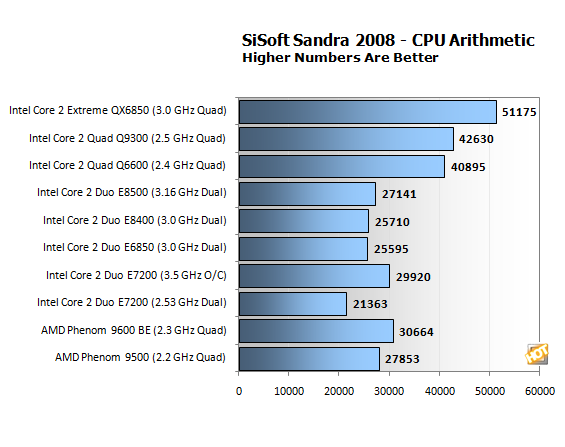Intel Core 2 Duo E7200, Eco-Friendly Performance
Testbed and SiSoft Sandra
|
- Intel Core 2 Duo E7200 (2.53 GHz Dual-Core, 45nm)
- Intel Core 2 Duo E8500 (3.16 GHz Dual-Core, 45nm)
- Intel Core 2 Duo E8400 (3.0 GHz Dual-Core, 45nm)
- Intel Core 2 Duo E8650 (3.0 GHz Dual-Core, 65nm)
- Intel Core 2 Quad Q9300 (2.5 GHz Quad-Core, 45nm)
- Intel Core 2 Quad Q6600 (2.4 GHz Quad-Core, 65nm)
- Intel Core 2 Exteme QX6750 (3.0 GHz Quad-Core, 65nm)
- AMD Phenom 9600 Black Edition (2.3 GHz Quad-Core, 65nm - TLB Patch Not Enabled)
- AMD Phenom 9500 (2.2 GHz Quad-Core, 65nm - TLB Patch Not Enabled)
- eVGA Nvidia nForce 680i LT SLI Motherboard (For Intel Testing)
- MSI K9A2 Platinum AMD 790FX Motherboard (For AMD Testing)
- Kingston HyperX DDR2-800 Memory (4 x 1 GB, CAS 4-4-4-12)
- Nvidia GeForce 8800 GT 512 MB (169.74 Driver)
- Western Digital Raptor 74 GB Hard Drive)
- Plextor PX-755SA DVD+/-RW Drive
- Corsair HX620W 620W Power Supply
- Microsoft Windows Vista Ultimate Edition (32-bit, SP1)
|



At its stock clock speed, the Core 2 Duo E7200 isn’t all that impressive in terms of raw computing power. Its arithmetic processing and memory bandwidth levels are low with respect to the rest of our test pack, but that’s to be expected as it’s the lowest priced option in here. The multimedia numbers are quite good, and of course the inclusion of SSE4 support helps here. As you’ll notice, the 2.53 GHz dual-core E7200 chip is able to perform at the same speed as a 3.0GHz E8650, which is based on Intel’s prior generation dual-core technology, a solid sign of improvement in multimedia performance with this new architecture.
When overclocked, the Core 2 Duo E7200 at 3.5 GHz is able to outperform Intel’s Core 2 Duo E8500, the fastest member of the “Wolfdale” family to date.






